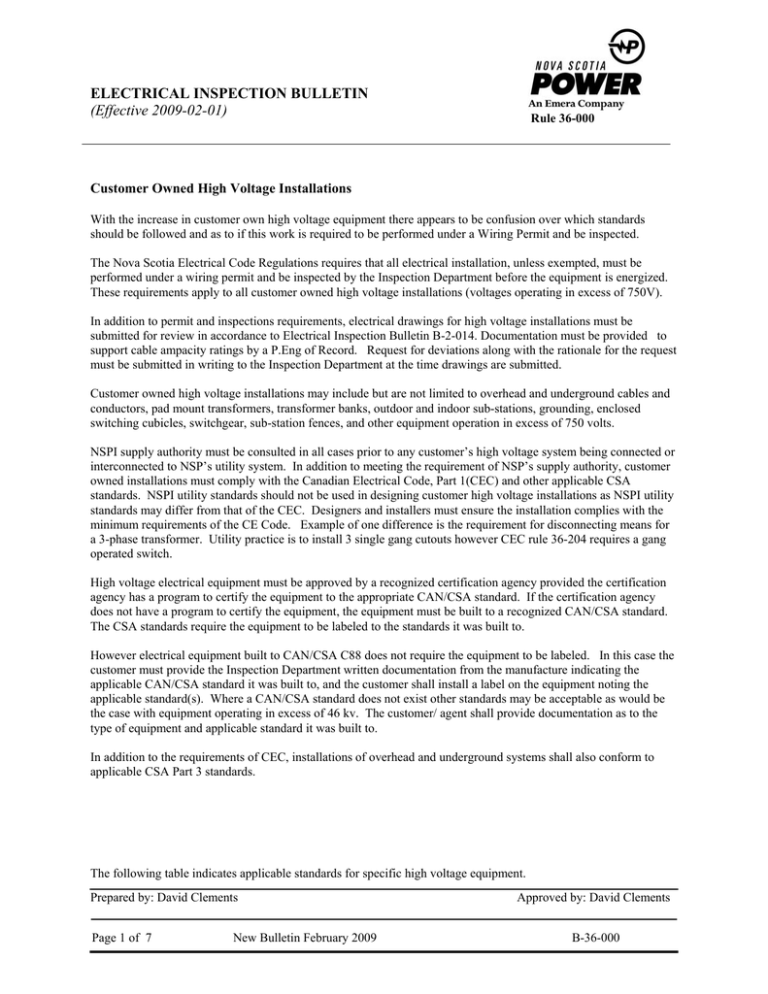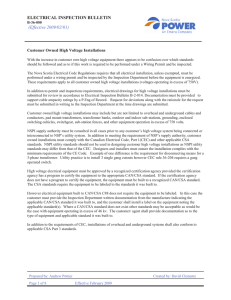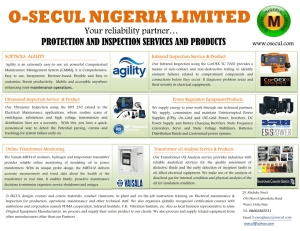B-36-000 - Nova Scotia Power
advertisement

ELECTRICAL INSPECTION BULLETIN (Effective 2009-02-01) Rule 36-000 Customer Owned High Voltage Installations With the increase in customer own high voltage equipment there appears to be confusion over which standards should be followed and as to if this work is required to be performed under a Wiring Permit and be inspected. The Nova Scotia Electrical Code Regulations requires that all electrical installation, unless exempted, must be performed under a wiring permit and be inspected by the Inspection Department before the equipment is energized. These requirements apply to all customer owned high voltage installations (voltages operating in excess of 750V). In addition to permit and inspections requirements, electrical drawings for high voltage installations must be submitted for review in accordance to Electrical Inspection Bulletin B-2-014. Documentation must be provided to support cable ampacity ratings by a P.Eng of Record. Request for deviations along with the rationale for the request must be submitted in writing to the Inspection Department at the time drawings are submitted. Customer owned high voltage installations may include but are not limited to overhead and underground cables and conductors, pad mount transformers, transformer banks, outdoor and indoor sub-stations, grounding, enclosed switching cubicles, switchgear, sub-station fences, and other equipment operation in excess of 750 volts. NSPI supply authority must be consulted in all cases prior to any customer’s high voltage system being connected or interconnected to NSP’s utility system. In addition to meeting the requirement of NSP’s supply authority, customer owned installations must comply with the Canadian Electrical Code, Part 1(CEC) and other applicable CSA standards. NSPI utility standards should not be used in designing customer high voltage installations as NSPI utility standards may differ from that of the CEC. Designers and installers must ensure the installation complies with the minimum requirements of the CE Code. Example of one difference is the requirement for disconnecting means for a 3-phase transformer. Utility practice is to install 3 single gang cutouts however CEC rule 36-204 requires a gang operated switch. High voltage electrical equipment must be approved by a recognized certification agency provided the certification agency has a program to certify the equipment to the appropriate CAN/CSA standard. If the certification agency does not have a program to certify the equipment, the equipment must be built to a recognized CAN/CSA standard. The CSA standards require the equipment to be labeled to the standards it was built to. However electrical equipment built to CAN/CSA C88 does not require the equipment to be labeled. In this case the customer must provide the Inspection Department written documentation from the manufacture indicating the applicable CAN/CSA standard it was built to, and the customer shall install a label on the equipment noting the applicable standard(s). Where a CAN/CSA standard does not exist other standards may be acceptable as would be the case with equipment operating in excess of 46 kv. The customer/ agent shall provide documentation as to the type of equipment and applicable standard it was built to. In addition to the requirements of CEC, installations of overhead and underground systems shall also conform to applicable CSA Part 3 standards. The following table indicates applicable standards for specific high voltage equipment. Prepared by: David Clements Page 1 of 7 New Bulletin February 2009 Approved by: David Clements B-36-000 High Voltage Equipment Application Enclosed Switchgear up to 46KV Enclosed Switchgear up to 46KV Air Cooled Distribution Transformer(Dry Type) up to 46kV Oil/Liquid Filled Power Transformer Indoors or Outdoors within a fenced station Outdoors Single and Three Phase Oil/Liquid Filled Distribution Transformer (Up to 3MVA) ONAN only Single and Three Phase Liquid Filled Distribution Transformer (Up to 3MVA) LNAN only Low –Profile, Single Phase Tamper Resistant Pad Mount Transformer with Separable Insulated Connectors (Up to 27.6/16.8 kV) (Up to 167 KVA) Three Phase Tamper Resistant Pad Mount Transformer with Separable Insulated Connectors (Up to 27.6/16.8 kV) (Up to 3000 KVA) Three Phase, Live-Front, Pad Mounted Distribution Transformer Tamper Resistance Oil/Liquid Filled Tamper Resistant Pad Mount Transformer ONAN and LNAN only Indoors or Outdoors Equipment Standard (see note 1) Certified to C22.2 No.31-04 Certified to C22.2 No.31-04 (Tamperproof Design) Certified to C22.2 No.47-M90 (R2007) Outdoors within fenced in station, or indoor within a vault Outdoors within fenced in station, or indoor within a vault Built to CAN/CSA C88-M90 (R2004) Outdoors within fenced in station, or indoor within a vault Built to CAN/CSA-C2.1-06 Outdoors ( no fence required) Built to CAN/CSA-C227.3 06 Outdoors ( no fence required) Built to CAN/CSA-C227.4 06 Outdoors ( no fence required) Built to CAN/CSA C227.5-08 Outdoors ( no fence required) Built to CAN/CSA C88-M90 (R2004) and built to tamperproof requirements in C227.4 Built to CAN/CSA-C2.1-06 Transformer Designation ONAN- Oil Filled Natural Cooling LNAN- Flame-retardant Liquid filled natural cooling Note 1: The information indicated in the equipment standard column shall appear on the equipment. Station Ground Resistance Page 2 of 7 New Bulletin February 2009 B-36-000 Testing/Commissioning of High Voltage Stations and Unit Substations In order to ensure compliance with Section 36 of the CEC and in particular rule 36-304(4), (Station ground resistance) after completion of construction equipment shall not be energized until a testing/commissioning report on the complete installation is provided to NSPI’s Chief Electrical Inspector, an electrical inspection has been completed by the Inspection Department and all applicable checklists (attachments 1-3) have been submitted with the commissioning report. The testing /commissioning report is to be completed by an acceptable independent agency other than the installing electrical contractor. The report submitted by the agency must indicate that the High Voltage installation has been successfully tested in accordance with requirements of Section 36 of the CEC and that the installation is ready to be energized. Where an installation falls under the station exemption rule (36-306), the consultant must demonstrate to the Inspection Department that the potential rise of the station shall not exceed the values specified in Table 52 during the lifetime of the station. The testing / commissioning report must include (but not limited) to the following: (1) (2) (3) (4) (5) (6) (7) Operation of all isolating and disconnecting means; Operation of all required interlocks between fuse compartments, load breaking or isolating means; CAN/CSA standard that transformer(s) are built to; Calculation of step and touch voltages and ground resistance test; Protection coordination study; Visual inspection of grounding conductors and ground connections Confirmation that that all test are completed and the complete installation complies with the CEC and station is ready to be energized. Indication that all equipment is rated to withstand the maximum available fault levels (8) The design of the station ground electrode can be found in CEA Report 249 D541 “Simplified Rules for Grounding Customer-Owned High Voltage Substations or IEEE Standard No. 80 “Guide for Safety in AC Substation Grounding” Acknowledgements: References to equipment standards provide by Canadian Standards Association (CSA) Information contained in checklist provided by City of Vancouver Electrical Inspection Department Page 3 of 7 New Bulletin February 2009 B-36-000 ATTACHMENT #1 – to NS Power Electrical Inspection Bulletin 36-000 Note 1: To be completed by the Professional Engineer of the Testing/Commissioning Agency GENERAL CHECKLIST FOR H.V. UNIT SUBSTATION Project Name: Wiring Permit Number: Installation Address: Plans Review Number: REFERENCES ITEM NO. DESCRIPTION 1 (a) H.V. Station Ground Resistance Report (See Attachment 2) H.V. Equipment approval Clearance and spacing of live parts 2 3 4 5 6 7 Operation of H.V. switches Interlocks Switch, fuse, and breaker ratings Transformer overload and overheating protection (a) Relay and tripping device settings (b) Transformer core temperature device Installation integrity: (a) Insulation (b) Torqued as per installation spec.’s (c) Stand-off supports and bushings Interconnection between pieces of electrical equipment assembled on site is in conformance with the shop drawings and in accordance with the CE Code Part I Tested H.V. Station (Unit Substation) is ready to be energized 8 9 10 (Applicable CEC Rules, NS Power Electrical Inspection Bulletins, NS Power Authority Directives) Conformance to the referenced requirements Yes No 36-304 2-024 36-108; 36-110; 36-212; Tables 30, 31,32,33,34 & 35 36-212; 36-214 36-208; 36-214 36-202; 36-204; 14-402 26-252 As per shop drawings Shop drawings of unit substation; CE Code, Part I NS Power Bulletin 36-000 Additional Comments: Testing Agency: P.Eng. Name: Signature: Address: Affix Professional Seal Telephone: Facsimile: Email: Page 4 of 7 New Bulletin February 2009 B-36-000 ATTACHMENT #2 – to NS Power Electrical Inspection Bulletin 36-000 Note 1: To be completed by the Professional Engineer of the Testing/Commissioning Agency or by the Professional Engineer responsible for the design of the H.V. installation. (P.Eng. of record) Note 2: Completed report – to be provided as part of Attachment 1 (Item 1) GENERAL CHECKLIST FOR H.V. SERVICE Project Name: Wiring Permit Number: Installation Address: Plans Review Number: HIGH VOLTAGE STATION GROUND RESISTANCE REPORT Wiring Permit Number: Installation Address: Testing Agency: Item Requirements of Table 52 1 Type of Soil (specify): 2 Measured Resistance of the station Ground Electrode 3 Calculated Step Voltage at the HV station 4 Calculated Touch Voltage at the HV station Conformance with applicable requirements of Table 52 Yes No Company Name: (if other than the testing agency): P.Eng. Name: Signature: Date: Address: Affix Professional Seal Telephone: Facsimile: Email: Page 5 of 7 New Bulletin February 2009 B-36-000 ATTACHMENT #3 – to NS Power Electrical Inspection Bulletin 36-000 Note 1: To be completed by the Professional Engineer responsible for the design of the H.V. installation (P.Eng. of record) GENERAL CHECKLIST FOR H.V. SERVICE Project Name: Wiring Permit Number: Installation Address: Plans Review Number: REFERENCES Item No. DESCRIPTION 1 Horizontal clearance of H.V. conductors from adjacent structures; guarding 2 Service raceways, including drainage and pull box facilities 3 Working space; entrance to and exit from 4 Space for service and distribution equipment 5 6 Access to nameplates and parts requiring maintenance Presence of other than electrical equipment (a) Dielectric liquid-filled equipment, indoors 7 (b) Dielectric liquid-filled equipment, outdoors 8 9 Illumination of equipment Warning notices Electrical equipment service room/Vault (a) Location (b) Construction 10 (c) Door Swing (d) Fire alarm system devices (Smoke detectors if not sprinklered) (e) Adjacent Hazardous Areas (f) If sprinklered, adequate protection for electrical equipment Ventilation 11 (a) Proof that the system is adequate and suitable for the purpose (b) Intake location Page 6 of 7 New Bulletin February 2009 (applicable CEC Rules, NS Power Inspection Bulletin and Supply Authority Directives, Dept. of Labour & Workforce Development Bulletins) Conformance to the referenced requirements Yes 36-004; 36-110; Table 33 2-320; 6-300; 12-942; 36-100 2-308; 2-310; Table 56 6-206; 26-352; 36-200 2-118 2-120 26-012; 26-242; 36212 26-014; 26-242; 36212 2-314; 26-356 36-006 26-012 36-200 NBCC DIV. B 3.6.2.1/3.6.2.7 NBCC DIV. B 3.6.2.6 NBCC DIV. B 3.6.2.7 (3)(b) 20-102(5) 26-008; 26-248(5) NBCC DIV. B 3.6.2.7(6); 2-318; Appendix B NBCC DIV. B 6.2.3.12 B-36-000 No N/A REFERENCES Item No. DESCRIPTION Grounding and bonding requirements (a) Station ground electrode (b) Connections to the station ground electrode 12 (i) Method of connection (as specified by the design professional) (ii) Conductor sizes (as specified by the design professional) (c) If a ground bus (pad) for testing purposes is installed: (i) Accessibility (ii) Conductors marked for testing purposes (d) If a gang-operated switch is installed: (i) Operating shaft grounded (ii) 1.2 m x 1.8 m gradient control mat (iii) positioned for vertical or horizontal operation (iv) connection of the mat by two separate conductors (size and method of connection as specified by the design engineer) (e) If a metallic fence is installed: (i) located minimum 1 m inside perimeter of station ground electrode area (ii) connections to the fence L.V. breakers and fuses: 13 (a) Size/trip setting 14 (b) Interrupting capacity Ground Fault protection or indicator 15 L.V. metering sockets 16 Other – (Please specify) (applicable CEC Rules, NS Power Inspection Bulletin and Supply Authority Directives, Dept. of Labour & Workforce Development Bulletins) Conformance to the referenced requirements Yes No CEC Section 10 36-300; 36-302 36-104(5); 36-308; Appendix B 36-300; 36-308; Appendix B CEC Table 51 2-312 36-308(7); 2-100 36-310(1)(a) or (b) 36-312 Section 14 Accepted Plans and Specifications 14-012; 14-014; 14-102; 10-106(2) NS Power Metering Standards Additional Comments: Company Name: P.Eng. Name: Signature: Address: Affix Professional Seal Telephone: Facsimile: Email: Page 7 of 7 New Bulletin February 2009 B-36-000 N/A


